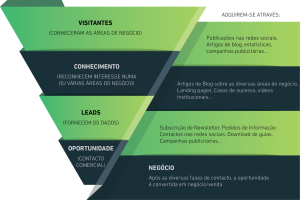Did you know that creating a sales funnel is one of the most effective tactics when it comes to maximizing your marketing efforts and generating conversions? The better you understand what a sales funnel is, the better you can optimize yours to achieve the desired goals, namely converting new customers. In this article we will explain what a sales funnel is and how you can use it to your advantage.
What is a sales funnel?
A sales funnel is a marketing term given to the potential journey that customers go through until they reach the act of purchase. It is thus a visual description of the different stages of the sales process, from the beginning to the end, i.e. to when you actually succeed in converting the customer.
If you are questioning the importance of a sales funnel, we help you gain a better understanding of this marketing technique: a sales funnel helps you understand what goes through the minds of potential customers at each stage of their buying journey. This knowledge then allows you to invest in the right marketing activities and create relevant messages in order to generate more conversions.
What are the different stages of a sales funnel?
Typically, the sales funnel is divided into three or four steps that represent the mindset of a potential customer during their journey to making a purchase. However, the names and number of steps in the sales funnel vary depending on the companies’ sales model, so there is no single correct way to determine your own scheme.
A common sales funnel is drawn as an inverted triangle and is usually organized as follows: Discovery Phase at the top, Interest and Decision Phases in the middle, and Action Phase at the end of the funnel.
- Discovery: this is the phase where the potential customer discovers who you are and learns about your products or services. At this stage, the person is still a long way from making a purchase. Awareness about yourself and your company may have resulted from a Google search or social media, for example.
- Interest: At this stage, people have moved from discovery to interest, that is, after finding your website, they have not abandoned it, but have chosen on the other hand to continue exploring your brand in order to decide whether your product or service can be useful to them. At this stage, you should take good opportunities to educate and inform the prospect as to how you can meet their needs.
- Decision: At this stage, the customer already knows that they want to make a purchase, but most likely they are still considering which option is best for them, and your brand may not yet be the obvious choice. At this stage, factors such as the price, quality and durability of the product, and other available options can influence the potential customer’s decision. So it is very important to make sure that you put in place effective tactics to convert customers, such as including testimonials from previous customers who are satisfied with your product or else a full refund offer in case of return.
- Action: We have finally reached the end of the sales funnel and the prospect is ready to make a purchase. Don’t forget that you should use this stage to encourage future purchases as well. However, it is possible that, even at this stage, the potential customer does not make a purchase, in which case you should try to understand why, in order to create solutions to prevent this from happening again.
Below, we present an alternative to the “traditional” sales funnel, because as already mentioned, there is no single correct way to create such a scheme.
How to optimize your sales funnel to generate more conversions?
It is very important to optimize each step of the sales funnel, so as not to lose potential customers along the way. After all, we want them all to get to the last stage of the funnel and make the purchase. Below we share some actions you can put in place to generate more conversions:
- Know your audience
You must know your target audience in order to decide what language to use and what content to bet on to generate the desired conversions. Focus on your ideal persona and meet what they would like to see/consume.

- Create relevant content
You must create content that appeals to your potential customer, but more importantly, that answers their curiosities, questions, and needs. For example, you should try to educate through publications on relevant topics and inform through a question and answer page.
- Get the prospect’s email address
If you want to nurture a close, trusting relationship with a potential customer, you should get the customer’s email address in order to stay in touch and share relevant, personalized information. For example, if the person concerned ends up not making a purchase, you can send them recurring emails so that they remember your brand and possibly regain interest.
- Refer to testimonials
One of the first things we do when we are undecided about buying a product or service is to look for testimonials from people who have been through the same process. The truth is that we tend to trust a brand more once we get to know positive stories from other people who have already bought the products or services of the company in question. Keep this in mind and include positive testimonials from past customers on your online pages.
- Use strong CTAs
Call to Actions can be really useful and effective when used well. Choose a sentence that is short, direct, and catchy enough to motivate the prospect to make a purchase. Something as simple as “try it now” or “start your free trial” can really make a difference!
The sales funnel is thus a very effective technique when it comes to getting to know your potential customer better and generating more conversions. Don’t forget that you can customize your own sales funnel in the way that is most relevant to you.







